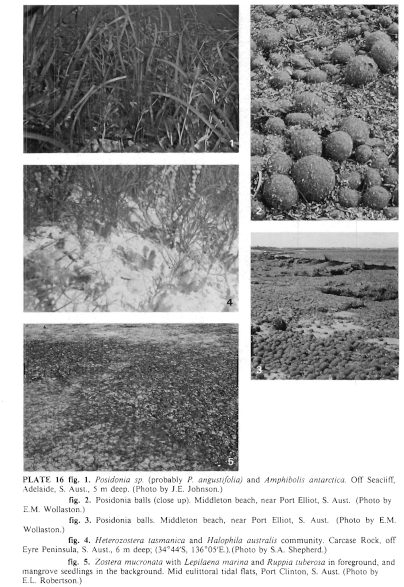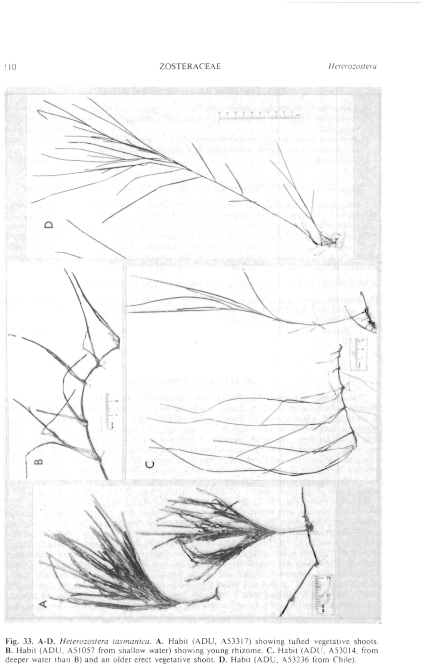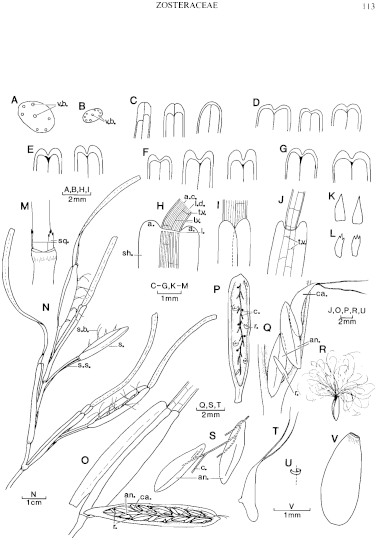|
|
|
|
|
|||||||||||
|
Electronic Flora of South Australia Species Fact Sheet
Phylum Magnoliophyta – Subphylum Seagrasses – Class Liliopsida – Subclass Alismatidae – Order Potamogetonales – Family Zosteraceae
Selected citations: Aston 1973: 325, figs 134–136a,b. Green 1981: 5. Jacobs & Williams 1980: 454. Jessop 1978: 73. Sainty & Jacobs 1981: 429.
Synonym
Zostera tasmanica Martens ex Ascherson 1867a: 15. Setchell 1933: 816. Willis 1970: 68.
Monoecious; perennial (Fig. 33A–D) with monopodially branched, herbaceous, creeping rhizomes. Rhizomes (0.5–) 1.5–2 (–3) mm in diameter bearing a single leaf and usually 2 roots at each node, often somewhat flexuous (Fig. 33B,C) when young and actively growing, becoming dark-brown to black and brittle with age. Roots unbranched. Vegetative shoots (Fig. 33A,B,D) erect, arising at intervals of 1-several nodes, (5–) 25–40 (–50) cm high; stems becoming wiry, dark-brown to black, about 1 (–2) mm in diameter, bearing a tuft of leaves. Internodes of both rhizomes and erect stems in transverse section (Fig. 34A,B) showing 4–12 vascular bundles in the outer cortex. Leaves (Fig. 34C–J) 2–6 (–8) per shoot; sheath (Fig. 34H–J) 1–4 cm long, open, with margins narrowly overlapping, ligule about 0.5 mm long, auricles about 1 mm long; blade linear, (10–) 20–25 (–35) cm long, (0.5–) 1–2 (–3) mm broad with 3 longitudinal veins (Fig. 34C–J), the 2 lateral ones submarginal, longitudinal air canals (Fig. 34H,I) 5–9 on each side of the midvein, transverse veins (Fig. 34H–J) at regular intervals usually continuous from the midvein to the submarginal veins; apex (Fig. 34C–G) rounded, usually deeply notched, sometimes with fine denticulations. Squamules (Fig. 34K–M) lanceolate and often dentate, two per node. Fertile shoots (Fig. 34N) erect, sympodially branched, each branch with one to a few spathes, resembling the vegetative leaves but borne on flattened stalks 5–10 mm long and sometimes connate to the axis in the lower part; spathe (Fig. 340) 12–35 mm long, somewhat inflated and usually broader (up to 5 mm) than its blade, which is 5–10 cm long and up to 4 mm broad (frequently deciduous after flowering), spadix (Fig. 340,P) borne on a flattened stalk 1–3 (–5) mm long and bearing 3–6 male (Fig. 34Q–S) and 3–6 female flowers (Fig. 34Q,T); retinacules (Fig. 340-Q,U) lanceolate, 1–2 (–3) mm long, and 0.3–0.5 mm broad, L/B 2.5–4 (–6), usually one near each male flower. Seed (Fig. 34V) ellipsoid, 2–3 (–4) num long, testa dark-brown to black, shiny, with very faint longitudinal striations.
Lectotype from Port Phillip, Victoria (F. Mueller, 1866); in MEL, 2905.
Selected specimens: Whitfords Beach, W. Aust., 5 m deep (Lipkin, 2.ii.1982; ADU, A52979). Kellidie Bay, Coffin Bay, S. Aust., 3 m deep (Womersley, 5.xii.1975; ADU, A46917). Barker Rocks, Yorke Pen., S. Aust., 0.5 m deep in pools on rock platform (Robertson, 15.xi.1981; ADU, A52725). Stenhouse Bay, S. Aust., 6–7 m deep (Hartwig, 9.iv.1982; ADU, A53014). Aldinga, S. Aust., reef pools (Skinner, 1.vi.1980; ADU, A51057). Kelso, Tamar R. estuary. Tas., uppermost sublittoral, edge of channel (H. Robertson, 12.viii.1982; ADU, A53317). Bakers Beach, just E of Port Sorel! inlet, Tas., drift (H. Robertson, 14.xi.1982; ADU, A53817). Pto Aldea, Bahia Tongoy, near Coquimbo, Chile, inshore edge (Phillips, 1.v.1981; ADU. A53236).
Distribution: Widely distributed around the southern Australian coast including Tasmania, from Dongara, W. Aust. to Jervis Bay, New South Wales. Records from the Sydney region are drift specimens only (Jacobs & Williams 1980, p. 453). Also known from one locality in Chile. Heterozostera tasmanica usually occurs subtidally (P1. 16 fig. 4) in shallow coastal waters to about 8 m deep but it has also been found in deeper, clear oceanic water (e.g. Investigator Strait, S. Aust., 31 m deep ( Watson, 13.i.1971; ADU, A38216).
Taxonomic notes: A single sterile specimen of H. tasmanica was collected from the coast of Chile in 1864 by Phillipi. It has recently been found growing extensively in the same region (Phillips et al. 1983). A duplicate is in ADU (see Fig. 33D). Only vegetative material has been found but it appears to be the same species as that from southern Australia. This view is supported by a comparison of secondary compounds in the leaves of the Chile material with Heterozostera from Australia (McMillan 1983).
Den Hartog (1970) described branching of the rhizome in H. tasmanica as sympodial and used this as a diagnostic character. Tomlinson (1982) states that examination of a large population does not support this and refers to the branching as obscurely monopodial.
The erect vegetative shoots of H. tasmanica are usually deciduous in winter. The remaining prostrate system (Fig. 33B) then appears very similar to Zostera muelleri (Fig. 37B). It can be readily distinguished by cutting a transverse section through the rhizome and observing the number of lateral vascular bundles (see key to genera above and Figs 34A, 39A).
References:
ASCHERSON, P. (1867a). In Sber. Ges. naturf Freunde Berl. 1867, 15.
ASTON, H. (1973). Aquatic plants of Australia. (Melbourne University Press: Melbourne.)
DEN HARTOG, C. (1970). The seagrasses of the World. Verh. k. ned. Akad. Wet. Afd. Natuurk., ser. 2, 59(1), 1–275 (-1–31 Plates).
GREEN, J.W. (1981). Census of the Vascular Plants of Western Australia. (Western Australian Herbarium: South Perth.)
JACOBS, S.W.L. & WILLIAMS, A. (1980). Notes of the genus Zostera s. lat. in New South Wales. Telopea 1, 451–455.
JESSOP, J.P. (1978). J.M. Black's Flora of South Australia. 3rd edn. Part I. (Govt. Printer: Adelaide.)
McMILLAN, C. (1983). Comparison of secondary compounds in Heterozostera tasmanica from Australia and Chile. Aquat. Bot. 15, 205–207.
PHILLIPS, R.C., SANTELICES, B., BRAVO, R. & McROY, C.P. (1983). Heterozostera tasmanica (Martens ex Ascherson) den Hartog in Chile. Aquat. Bot. 15, 195–200.
SAINTY, G.R. & JACOBS, S.W.L. (1981). Water Plants of New South Wales. (Water Resources Commission of New South Wales: Sydney.)
SETCHELL, W.A. (1933). A preliminary survey of the species of Zostera. Proc. nail Acad. Sci., Wash. 19, 810–817.
TOMLINSON, P.B. (1982). Helobiae (Alismatidae) including the seagrasses. Vol. VII. Anatomy of the Monocotyledons (ed. C.R. Metcalfe). (Clarendon Press: Oxford.)
WILLIS, J.H. (1970). A handbook to plants in Victoria. Vol. 1. 2nd edn. (Melbourne University Press: Melbourne.)
The Marine Benthic Flora of Southern Australia Part I complete list of references.
Publication:
Womersley, H.B.S. (31 May, 1984)
The Marine Benthic Flora of Southern Australia
Part I
©Board of the Botanic Gardens and State Herbarium, Government of South Australia
Illustrations in Womersley Part I, 1984: PLATE 16 fig. 4; FIGS 33, 34.

Plate 16 enlarge
PLATE 16 Fig. 1. Posidonia sp. (probably P. angustifolia) and Amphibolis antarctica. Off Seacliff, Adelaide, S. Aust., 5 m deep. (Photo by J.E. Johnson.)
Fig. 2. Posidonia balls (close up). Middleton beach, near Port Elliot, S. Aust. (Photo by E.M. Wollaston.)
Fig. 3. Posidonia balls. Middleton beach, near Port Elliot, S. Aust. (Photo by E.M. Wollaston.)
Fig. 4. Heterozostera tasmanica and Halophila australis community. Carcase Rock, off Eyre Peninsula, S. Aust., 6 m deep; (34°44'S, 136°05'E.). (Photo by S.A. Shepherd.)
Fig. 5. Zostera mucronata with Lepilaena marina and Ruppia tuberosa in foreground, and mangrove seedlings in the background. Mid eulittoral tidal flats, Port Clinton, S. Aust. (Photo by E.L. Robertson.)

Figure 33 enlarge
Fig. 33. A–D. Heterozostera tasmanica. A. Habit (ADU, A53317) showing tufted vegetative shoots. B. Habit (ADU, A51057 from shallow water) showing young rhizome. C. Habit (ADU, A53014, from deeper water than B) and an older erect vegetative shoot. D. Habit (ADU, A53236 from Chile).

Figure 34 enlarge
Fig. 34. Heterozostera tasmanica. A. T.S. rhizome showing arrangement of vascular bundles (v.b.). B. T.S. erect stem showing arrangement of vascular bundles (v.b.). C. Juvenile leaf apices (from Baker Beach, Tas.) D. Mature leaf apices (from same plant as C). E. Leaf apices (from Kelso, Tas.). F. Leaf apices (from Barker Rocks, S. Aust.). G. Leaf apices (from Tongoy, Chile). H. Portion of leaf (adaxial view). Junction of blade and sheath (sh.) (opened out) showing ligule (l.), auricles (a.), longitudinal veins (1.v.), transverse veins (t.v.) and longitudinal diaphragms (l.d.) separating longitudinal air canals (a.c.). I. Portion of leaf (adaxial view) showing overlapping sheath margins. J. Portion of leaf (adaxial view). Junction of blade and sheath showing regular transverse veins (t.v.). K. Pair of lanceolate squamules. L. Pair of squamules with dentate apices. M. Pair of squamules (sq.) at node, subtending leaf removed. N. Portion of fertile branch with 3 spathes (s.) with flattened stalks (s.s.). Note stigmatic branches (s.b.) projecting from enclosed spadices. 0. Spathe (opened out) showing spadix (pulled to one side) with anthers (an.) and carpels (ca.) in position. Note retinacules (r.). P. Spadix with flowers removed showing retinacules (r.) and anther connectives (c.). Q. Portion of spadix showing one female flower of a single carpel (ca.) and one male flower of 2 anthers (an.) next to a retinacule (r.). R. Anther dehiscing longitudinally liberating filiform pollen grains. S. Male flower of 2 anthers (an.) with connective (c.). T. Female flower with 2 stigmatic branches. U. Retinacule showing line of attachment. V. Seed. (A–D, K,N–U from ADU, A53817. E from ADU, A53317. F,V from ADU, A52725. G from ADU, A53236. H–J, L,M from ADU, A46917.)

|
Email Contact: State Herbarium of South Australia |

|